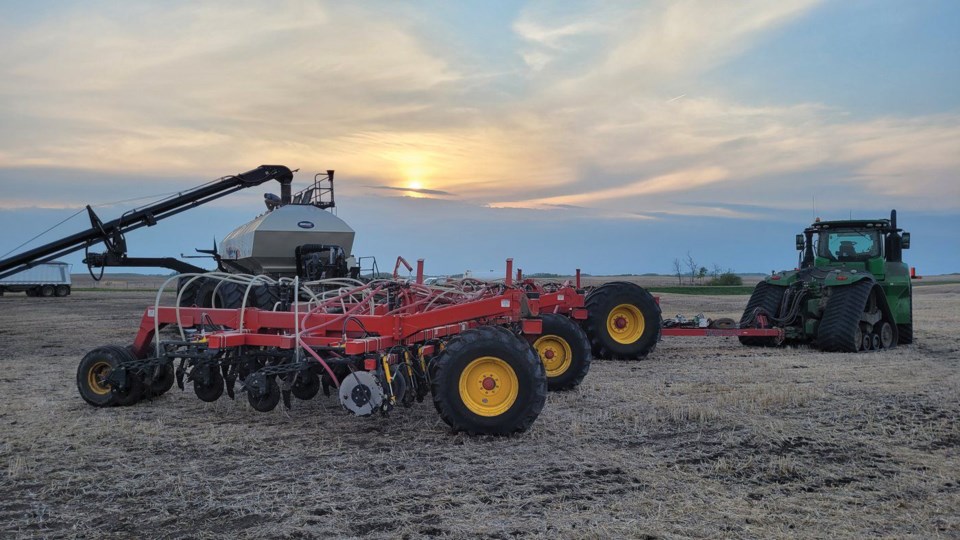MOOSOMIN — With spring temperatures finally arriving, it won’t be long before producers can hit the land.
According to Water Security Agency Spokesperson Patrick Boyle, the spring run-off in the region peaked a couple of weeks ago. The result—even with a last blast of winter in the form of a spring snowstorm on April 22—is an average moisture level, setting the stage for another good growing year.
“This snowfall is not going to come in behind those peak flows, so it’s just going to prolong them as they move through, but not going to create any issues,” he said. “It’s not a huge deal from our perspective, because everything had already moved off.”
What this time of year might look like was a concern last fall, as most of the province had below normal precipitation at freeze-up.
With a last blast of winter having gone through the area, plans of an early start to seeding have been put on hold. Moosomin-area producer Trevor Green has his sights on the middle of May as a target for when fields might be dry enough to work.
“I think we’ll be well beyond the first of May now,” he said. “Other years we started on the 20th of April, and this year we’ll get started on the 15th of May. The only difference when you get started on the 20th of April is you seed for 12 hours a day, and when you get started on the 20th of May, you sit for 21 hours a day!”
While crops like peas and barley can tolerate cooler temperatures and the unpredictable swings of late April, the safe bet is certainly to wait if possible.
“And then, May Long, guys can switch into canola or whatever,” Green said. “But right around here, I would say we’re going to be probably in excess of moisture now with this stuff.”
Certainly, this most recent snow event has differed from what producers have seen through the winter months. Moisture in the April 22 snowfall will likely push any sort of fieldwork plans two weeks further into the calendar.
“The wind was sucking up quite a bit of moisture before this, and we would have probably been right in ideal moisture conditions before this, but now we got a pretty good wet dump period right now,” Green said. “Most of the creeks and ravines maybe only ran for a day, or a day and a half, where we usually get at least three days to a week of runoff.”
Jeff Warkentin of The Hebert Group estimates the recent snowfall will push back seeding at their operation by about a week to 10 days.
“We were hoping to go and vote on April 28 and then start seeding when we got home,” he said, adding that approximately one foot of snow fell on their land. “It’s hard to tell exactly, but it has certainly warmed up this afternoon, and we’re starting to see some bare ground again. So we’ll see how much the ground will soak up.”
Warkentin credits a good thaw this spring that had a lot of low spots in the fields drying up nicely before the April 22 snow.
“We got to just take the extra time to make sure we’re organized so we can be as efficient as we can once the show does start,” he said, seeing the silver lining in the downtime. “When you think about it, there’s always those little things that you forgot to get ready. That’s what we’re doing is going through things with a fine-tooth comb and making sure we’re ready.”
By Rocanville, producer Rylar Hutchinson agreed with the mixed blessing of the snow event—a nice boost to moisture levels, but likely to delay getting into the field any time soon.
“Things were going good, and it was looking like a normal start to seeding,” he said. “But this late snowfall will push things back.
“There is good moisture in it, so I can’t complain, I suppose,” he continued. “It’s hard to say when we could hit the field, but it’ll be a later start than normal.”
In the Atwater/Stockholm area, Blake Duchek estimates his land received around 14 inches of wet snow.
“It was more like pure slush,” he said. “I bet there’s probably three to four inches of water out of this snow we will probably have.”
Initially, Duchek had May 1 targeted to begin seeding, but the precipitation will set him back almost one week.
“It was actually just getting nice, we were out pumping some water out in a couple different fields, and you could drive with a half-ton in the fields,” he said. “It was just getting to that point that it wasn’t greasy on top. We went backwards a little bit with the storm.”
With the slushy snow making things a muddy mess on gravel roads, even the RM of Fertile Belt graders couldn’t be deployed.
“The roads that didn’t get plowed yesterday morning or this morning, driving down on those, the ruts are over a foot deep, and they’re just froze solid,” he said.
In the Gerald area, Kevin Hruska reported the heaviest snowfall with two feet landing on his land.
“We’re going to be late seeding here in this area this year,” he said. “And we were wet in the first place. No problem snowmobiling right across any field here right at the moment!” he said last week.
As with the other producers the World-Spectator spoke with, Hruska is looking into almost the middle of May now as a possible entry to seeding, should the weather stay decent.
“I would say May 12, maybe something like that,” he said. “That’s where we’re probably hoping to start.”
The long-term forecast is showing a warming trend after April 28, with overnight lows above freezing for the most part. In 2024, about 13 per cent of producers had finished seeding by May 6.




